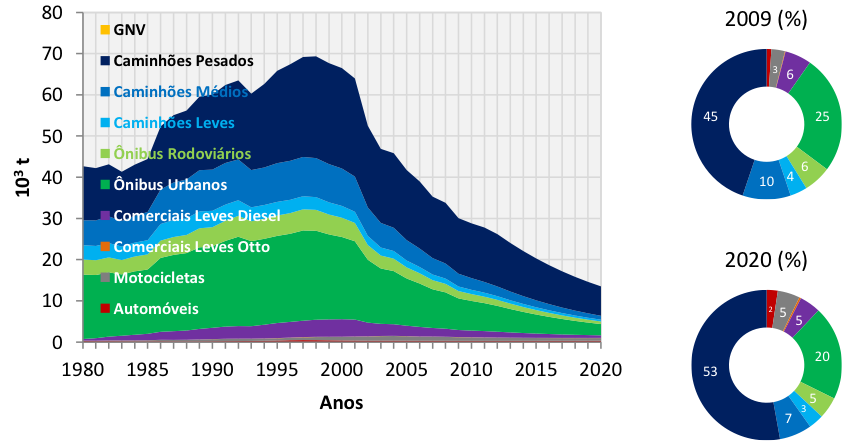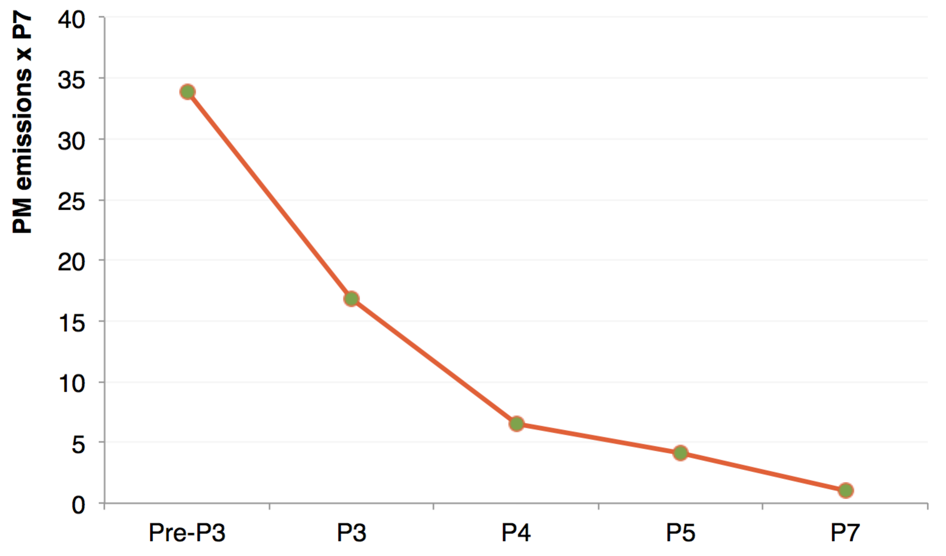Cost-benefit analysis of Brazil's heavy-duty emission standards (P-8)
Blog
Brazil’s vehicle fleet renewal program should aim to benefit from others' successes, and their mistakes
As Brazil’s economic crisis drags on, the Ministry of Development, Industry and Foreign Trade (MDIC) has begun to talk up a road vehicle scrappage program as a means of stimulating production in the automotive industry. Discussions between the national government and industry have actually been in progress for several years, but MDIC Minister Marcos Pereira has made headlines with a promise to roll out a fleet renewal program, as such scrappage schemes are more formally termed, in 2017. From MDIC press statements it’s safe to conclude that, apart from its core economic-stimulus objective, the program would aim to reduce greenhouse gas emissions and fuel consumption from older vehicles, and to improve road safety.
Any fleet renewal program should aim to ensure that the benefits to society exceed the costs. Not all succeed. An OECD study of scrappage programs in the United States, France, and Germany, all focused on fuel and carbon dioxide (CO2) reductions, showed that in all three cases the estimated value of scrapped vehicles exceeded the benefits to society from CO2 and nitrogen oxide (NOx) reductions, fuel savings, and road safety improvements. As it plans its own fleet renewal program, the MDIC is in a good position to profit from the experiences of other countries, avoid some of their mistakes and repeat some of their successes.
The table below compares nine fleet renewal programs implemented in the United States (nationwide), California (state-level), Germany, China, Mexico, and Chile. The first thing to note is that all of the most cost effective programs focus on air quality improvements and include heavy-duty vehicles as a targeted category. While heavy-duty vehicles typically account for a relatively small share of a national vehicle fleet, they contribute disproportionately to fuel consumption and to CO2 and local air pollutant emissions. Worldwide, heavy-duty diesels accounted for an estimated 80 percent of PM2.5 and NOx emissions from on-road vehicles in 2010.
| Program | Core stated objective | Vehicles targeted | Complementary policies | Cost effectiveness |
|---|---|---|---|---|
| California: Carl Moyer Program | Air quality (NOx) | Multiple; includes heavy-duty | Regulatory backstops | Yes; requirement of program |
| US: CARS (Cash for Clunkers) | Energy efficiency & GHG | Light-duty | – | No |
| US: National Clean Diesel Campaign | Air quality (PM & NOx) | Heavy-duty | – | Yes; requirement of program |
| Germany: Scrappage Bonus | Economic stimulus | Light-duty | Low emission zones | No |
| China: Vehicle Scrappage Programs | Air quality | Light and heavy-duty | Mandatory age limits & low emission zones | Not evaluated; incentives may offset negative equity impacts |
| Mexico: Modernize Federal Road Transportation | Economic stimulus | Heavy-duty | – | Yes, but low participation among small fleet operators |
| Mexico: Replace Microbuses with New Autobuses | Air quality | City buses | – | Yes; required replacement with newest emission controls |
| Chile: Swap Your Truck | Energy efficiency & Air quality | Heavy-duty trucks | – | Likely, but low participation among small fleet operators |
| US: Port of Los Angeles: Clean Truck Program | Air quality | Heavy-duty trucks | Truck impact fees & concession requirements | Yes; achieved 80% reduction in particulates |
Another thing to note is that the Carl Moyer Program and National Clean Diesel Campaign require that the program be cost effective; they don’t merely intend it. Applicants to California’s Voucher Incentive Program (a complementary initiative to the Carl Moyer Program) must submit verified data on annual vehicle usage (either mileage or fuel consumption) as well as characteristics of the vehicle to be replaced and the replacement vehicle. Fiscal incentives for replacement or retrofit are scaled based on the vehicle type, age and minimum annual usage level.
The Port of Los Angeles’ Clean Truck Program serves as a good example of how to improve the effectiveness of scrappage incentives using complementary policy measures. Starting in 2008, the Port of Los Angeles began restricting high-emitting diesel trucks from entering the port. The aim was to have 100% of the in-use drayage fleet operating in the port meet US EPA’s 2007 standards for new vehicles by 2012. The port offered financial subsidies and incentives to retrofit or replace older trucks, with the costs offset by environmental impact fees charged to non-compliant vehicles. By leveraging port fees and restrictions in combination with financial incentives, the Port of Los Angeles achieved an 80% reduction in drayage truck pollution in just four years.
Two of the least cost-effective programs made their goals economic stimulus and energy efficiency improvements for light-duty vehicles (as MDIC may be preparing to do). The US Cash for Clunkers program and Germany’s Scrappage Bonus did yield some benefits in terms of energy efficiency gains, economic growth, and improved air quality – but the benefits might have been substantially increased (relative to the costs) by more effective program design. In particular, Germany’s program suffered from problems of additionality – i.e., recipients of incentives would have replaced their vehicles anyway – a loss of potential fuel economy gains when scrapped vehicles were replaced by heavier and more powerful but relatively fuel-inefficient ones, and loosely enforced scrappage procedures. Similarly, the Cash for Clunkers program was not designed to optimize air quality or fuel economy benefits, nor was it supported by complementary policies to leverage benefits and reduce costs.
The history of these programs contains lessons applicable to Brazil. First, the Institute for Energy and the Environment (IEMA) projects that in 2020, heavy trucks and buses – which are predominantly fueled by diesel – will account for more than 75% of PM and NOx emissions from road vehicles in Brazil (chart). And in total, diesel vehicles will account for 92% of PM and 87% of NOx from road vehicles in 2020. Although they are less than 5% of the total on-road vehicle fleet, heavy buses and trucks in Brazil tend to be driven much further than light-duty vehicles each year and have longer useful lifetimes, making them a more cost-effective target for financial incentives on a per-vehicle basis. In Brazil, a first-phase fleet renewal program would be most effective by targeting the removal of old diesel heavy trucks and buses, in particular ones that are more than 14 years old and comply with Proconve standards P-3 and earlier.

PM emissions from on-road vehicles by vehicle type. Heavy-duty categories include Caminhões Pesados (heavy trucks), Caminhões Médios (medium trucks), and Ônibus (buses). [Source]
Second, while the core objectives of the fleet renewal program may include providing economic stimulus while reducing fuel consumption and greenhouse gas emissions and improving road safety, the most successful programs have a strong air quality component by design. As shown in the figure below, on a per vehicle-km basis, PM emissions from pre-P3 vehicles are more than 30 times those of P7 vehicles and more than 150 times the level expected for P8 vehicles. Scrapping diesel heavy trucks and buses with Pre-P3 or P3 technology as a first step of a renewal program would substantially reduce PM emissions, which are most directly harmful to human health.
Moreover, progressing to national P8 standards for new vehicles would ensure that new replacement vehicles are the cleanest available (for diesel technology). As we showed here, progressing to P8 standards nationwide would result in health benefits valued at eleven times the cost of improved vehicle technology. Additionally, P8 standards equivalent to Euro VI would include important fixes to reduce real-world NOx emissions in urban areas and ensure appropriate use of urea in NOx emission control systems. With these provisions, P8 standards would resolve the implementation issues of P7 without the need for an intermediate regulation.
Lastly, Brazil might avoid some of the pitfalls encountered by fleet renewal programs in Mexico and Chile, which had difficulty getting small fleet operators with limited financial resources to participate. Small fleet operators tend to operate the oldest vehicles and purchase only second-hand replacement vehicles. But a fleet renewal program that allowed small fleet operators to scrap their vehicles in exchange for a certificate – which they could sell through an official exchange to new-vehicle buyers – would create a financial incentive for cleaner new vehicles (i.e., P8 once models are locally available) and encourage both small and large fleet operators to participate in the program while contributing to real reductions in emissions of local air pollutants. (For a detailed description of how such a program can work, see here.)

Conceptual framework for a fleet renewal program that allows transfer of scrappage certificates [Source]
The MDIC will have many factors to consider in crafting a good fleet renewal program for Brazil. But mounting experience from around the world has made several things clear by now: successful programs have a focus on air quality; they ensure a cost-effective use of public resources; they target the dirtiest heavy-duty vehicles; they require replacement vehicles to be the cleanest available; they verify that replaced vehicles are really scrapped (not just resold); and they peg financial incentives to actual emission reductions. A first-phase fleet renewal program in Brazil could be most effective if it focused on removing old diesel heavy trucks and buses from the roads, in particular those older than 14 years that comply with Proconve standards P-3 and earlier. And Brazil could best leverage these emission reductions by combining a fleet renewal program with the introduction of P-8 standards.

